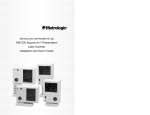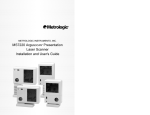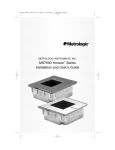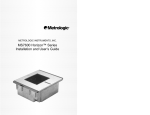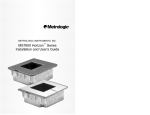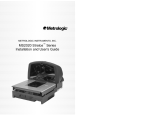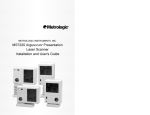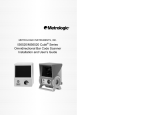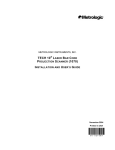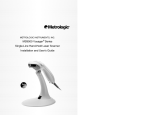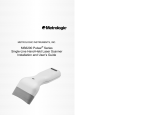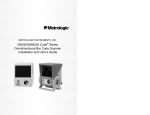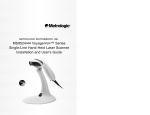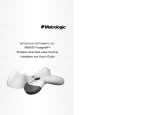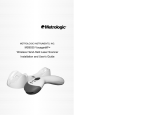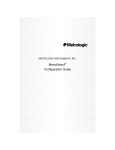Download MS7320 Series Installation and User's Guide
Transcript
METROLOGIC INSTRUMENTS, INC. MS7320 InVista™ Series Installation and User’s Guide LOCATIONS CORPORATE HEADQUARTERS North America Metrologic Instruments, Inc. 90 Coles Road Blackwood, NJ 08012-4683 Customer Service: 1-800-ID-METRO Tel: 856-228-8100 Fax: 856-228-6673 Email: [email protected] Internet: www.metrologic.com EUROPEAN HEADQUARTERS Germany, Middle East and Africa Metrologic Instruments GmbH Dornierstrasse 2 82178 Puchheim b. Munich, Germany Tel: +49 89 89019 0 Fax: +49 89 89019 200 Email: [email protected] Germany Email: [email protected] Spain Metrologic Eria lbérica SL Julián Camarillo 29, D-1 Edificio Diapasón 28037 Madrid Tel: +34 913 272 400 Fax: +34 913 273 829 Email: [email protected] Italy Metrologic Instruments Italia srl Via Emilia 70 40064 Ozzano dell’Emilia (BO) Tel: +39 0 51 6511978 Fax: +39 0 51 6521337 Email: [email protected] France Metrologic Eria France SA 69 Rue de la Belle Etoile ZI Paris Nord II, BP 50057 95947 – ROISSY CDG CEDEX Tel: +33 (0) 1 48.63.78.78 Fax: +33 (0) 1 48.63.24.94 Email: [email protected] United Kingdom Metrologic Instruments UK Limited 58 Tempus Business Centre Kingsclere Road, Basingstoke Hampshire RG21 6XG Tel: +44 (0) 1256 365900 Fax: +44 (0) 1256 365955 Email: [email protected] Singapore Metrologic Asia (Pte) Ltd No. 8 Kaki Bukit Place th 4 Floor Singapore 416186 Tel: 65-6842-7155 Fax: 65-6842-7166 Email: [email protected] China Metro (Suzhou) Technologies Co., Ltd. 221 Xing Hai Street Suzhou Industrial Park Suzhou, China 215021 Tel: 86-512-62572511 Fax: 86-512-62571517 Email: [email protected] Japan Metrologic Japan Co., Ltd. Matsunoya Building, 6 Floor 3-14-8 Higashiueno Taitou-Ku, Tokyo 110-0015 Japan Tel: 81-03-3839-8511 Fax: 81-03-3839-8519 Email: [email protected] Brazil Metrologic do Brasil Ltda. Rua da Paz 2059 CEP 04713-002 Chácara Santo Antônio São Paulo, SP, Brasil Tel: 55-11-5182-8226 Fax: 55-11-5182-8315 Email: [email protected] Outside Brazil Metrologic South America Rua da Paz 2059 CEP 04713-002 Chácara Santo Antônio São Paulo, SP, Brasil Tel: 55-11-5182-7273 Fax: 55-11-5182-7198 Email: [email protected] ASIA SOUTH AMERICA Copyright © 2002 by Metrologic Instruments, Inc. All rights reserved. No part of this work may be reproduced, transmitted, or stored in any form or by any means without prior written consent, except by reviewer, who may quote brief passages in a review, or provided for in the Copyright Act of 1976. Products and brand names mentioned in this document are trademarks of their respective companies. ii TABLE OF CONTENTS Introduction...........................................................................................................1 Scanner and Accessories.....................................................................................2 Installation for OCIA Interface ..............................................................................4 Installation for Keyboard Wedge Interface ...........................................................5 Installation for Stand-Alone Keyboard Interface ...................................................6 Installation for USB Interface................................................................................7 Installation for RS232 or Light Pen Interfaces ......................................................8 Installation for IBM 46xx Interface ......................................................................10 Installation of an Auxiliary Scanner.....................................................................11 Scanner Parts.....................................................................................................14 Maintenance .......................................................................................................14 Cable Cover Installation and Removal ...............................................................15 Face Plate Removal ...........................................................................................15 Scanner Labels...................................................................................................16 Audible Indicators ...............................................................................................17 Visual Indicators .................................................................................................18 Failure Modes .....................................................................................................19 Power Save Modes and the Multi-Function Button.............................................20 Scan Volume ......................................................................................................22 Depth of Field by Minimum Bar Code Element Width ........................................23 Flex Stand Installation ........................................................................................25 EAS Deactivation Antenna .................................................................................27 Troubleshooting Guide .......................................................................................28 Design Specifications .........................................................................................33 RS232 Demonstration Program..........................................................................35 Applications and Protocols .................................................................................36 Default Settings ..................................................................................................37 Scanner and Cable Terminations .......................................................................43 Limited Warranty ................................................................................................47 Notices................................................................................................................48 Patents ...............................................................................................................50 Index...................................................................................................................51 iii INTRODUCTION ™ The MS7320 InVista offers an outstanding combination of features, versatility, performance, and durability. This fixed mount laser bar code scanner provides ease of use and high throughput speeds by featuring a large, dynamic, and aggressive scan volume. The MS7320 is equipped with a multitude of standard features including: • Automatic scanning operation • Firmware updates via Flash ROM • EAS deactivation antenna • A Programmable Depth of Field • Supports multiple interfaces including USB and Keyboard Wedge • Custom edit the bar code data • OPOS and JPOS system compatible • RS232 auxiliary port for adding peripherals • PowerLink, user replaceable cables • Field replaceable outer window SCANNER INTERFACE MS7320-13 RS232, IBM 46xx, OCIA, Aux MS7320-37 RS232, Light Pen, Keyboard Wedge, Stand-Alone Keyboard, USB, Aux 1 SCANNER AND ACCESSORIES B ASIC K IT Part # MS7320 00-02407A-1 & 00-02407A-2 00-02896 52-52511A Description InVista Series Scanner ® MetroSelect Programming Guide Two Book Set MS7320 InVista Series Installation and User’s Guide 24” EAS Cable Guides also available for download at www.metrologic.com. O PTIONAL ACCESSORIES Part # 54-54xxx* Description Straight PowerLink Cable with built in power jack. 2.1 m (7') cord with short strain relief xxx* specifies connection to the host. Contact a customer service representative for additional information. 54-54002 MVC** ** 2 Keyboard Wedge PowerLink Cable with Adapter Cable Metrologic Voltage Converter Cable, +12VDC to +5.2VDC or -12VDC to +5VDC Contact a Metrologic Customer Service representative for additional information on Metrologic’s MVC cable series and the host connections available. 54-54020 Stand Alone Keyboard Wedge PowerLink Cable 54-54165 USB PowerLink Cable (Type A) 54-54667 RS232 AUX PowerLink Cable SCANNER AND ACCESSORIES (CONTINUED) O PTIONAL ACCESSORIES Part # Description AC to DC Power Transformer - Regulated 5.2V@650 mA output 45-45593 120V United States 45-45591 220V – 240V Continental European 45-45592 220V – 240V United Kingdom 45-45483 Flex Stand R EPLACEMENT P ARTS Part # Description 46-46624 Everscan Window Face Plate 46-46625 Standard Window Face Plate Other items may be ordered for the specific protocol being used. To order additional items, contact the dealer, distributor or call Metrologic’s Customer Service Department at 1-800-ID-METRO or 1-800-436-3876. 3 INSTALLATION FOR OCIA INTERFACE 1. Turn off the host system. 2. Connect the MVC cable to the 10-pin OCIA interface jack. It is nd the 2 round opening from the left side of the MS7320 (see figure 1). 3. Connect the other end of the MVC cable to the host. Before continuing verify that the MVC cable is connected to the appropriate interface jack on the scanner. An incorrect cable connection can cause communication problems or potential damage to the scanner. Plugging the scanner into the serial port of the PC does not guarantee that scanned information will appear at the PC. A software driver and correct configuration settings are also required for proper communication. 4. Turn on the host system. 5. Scan the Load OCIA Defaults bar code to configure the MS7320 for OCIA communication. 6. Figure 1: OCIA, Interface Load OCIA Defaults Snap on the cable cover. ³ 9 9 9 9 9 3 For additional communication options for OCIA interfaces refer to the MetroSelect Programming Guide (MLPN 00-02407A-1 & -2). Caution: To maintain compliance with applicable standards, all circuits connected to the scanner must meet the requirements for SELV (Safety Extra Low Voltage) according to EN 60950. To maintain compliance with standard CSA C22.2 No. 60950-00/UL 60950 and norm EN 60950, the power source should meet applicable performance requirements for a limited power source. 4 INSTALLATION FOR KEYBOARD W EDGE INTERFACE 1. Turn off the host system. 2. Disconnect the keyboard from the host. 3. Connect the PowerLink cable to the 10-pin nd KBW interface jack. It is the 2 round opening from the left side of the MS7320 (see figure 2). 4. Connect the “Y” end of the PowerLink cable to the keyboard and the keyboard port on the host. If necessary use the male/female adapter cable supplied with the scanner for proper connections. Before continuing verify that the PowerLink cable is connected to the appropriate interface jack on the scanner. An incorrect cable connection can cause communication problems or potential damage to the scanner. 5. Connect the external power supply to the power jack on the PowerLink cable. 6. Check the AC input requirements of the power supply to make sure the voltage matches the AC outlet. 7. Connect AC power to the transformer. The outlet should be near the equipment and easily accessible. 8. Scan the Load Keyboard Wedge Defaults bar code to configure the MS7320 for Keyboard Wedge communication. 9. Turn on the host system. 10. Snap on the cable cover. Figure 2: Keyboard Wedge Interfaces Load Keyboard Wedge Defaults ³ 9 9 9 9 9 4 Caution: To maintain compliance with applicable standards, all circuits connected to the scanner must meet the requirements for SELV (Safety Extra Low Voltage) according to EN 60950. To maintain compliance with standard CSA C22.2 No. 60950-00/UL 60950 and norm EN 60950, the power source should meet applicable performance requirements for a limited power source. 5 INSTALLATION FOR STAND-ALONE KEYBOARD INTERFACE 1. Turn off the host system. 2. Disconnect the keyboard from the host. 3. Connect the PowerLink cable to the 10-pin Stand-Alone Keyboard interface jack. It is nd the 2 round opening from the left side of the MS7320 (see figure 3). 4. Connect the other end of the PowerLink cable to the keyboard port on the host. Before continuing verify that the PowerLink cable is connected to the appropriate interface jack on the scanner. An incorrect cable connection can cause communication problems or potential damage to the scanner. 5. Connect the external power supply to the power jack on the PowerLink cable. 6. Check the AC input requirements of the power supply to make sure the voltage matches the AC outlet. 7. Connect AC power to the transformer. The outlet should be near the equipment and easily accessible. 8. Figure 3: Stand-Alone Keyboard Interface Load Keyboard Wedge Defaults Scan 1St ³ Scan the two bar codes in numbered sequence in order to configure the MS7320 for Stand-Alone Keyboard communication. Note: When scanning the bar codes, cover the code not being scanned to ensure the codes are read in the proper sequence. 9. Turn on the host system. 10. Snap on the cable cover. 9 9 9 9 9 4 Enable Stand-Alone Keyboard Wedge Scan 2nd ³ 5 1 5 5 1 5 Caution: To maintain compliance with applicable standards, all circuits connected to the scanner must meet the requirements for SELV (Safety Extra Low Voltage) according to EN 60950. To maintain compliance with standard CSA C22.2 No. 60950-00/UL 60950 and norm EN 60950, the power source should meet applicable performance requirements for a limited power source. 6 3 INSTALLATION FOR USB INTERFACE 1. Turn off the host system. 2. Determine if your application requires USB Keyboard communication protocols or USB Point-of-Sale communication protocols. 3. If you require USB Keyboard communication protocols, skip to step 4. If you require USB Point-of-Sale communication protocols set the dip switches shown in figure 4a to positions 1 and 2. 4. Connect the PowerLink cable to the 10-pin nd USB interface jack. It is the 2 round opening from the left side of the MS7320 (see figure 4b). 5. Connect the other end of the USB cable to the host. Figure 4a: POS Dip Switch Before continuing verify that the USB cable is connected to the appropriate interface jack on the scanner. An incorrect cable connection can cause communication problems or potential damage to the scanner. Plugging the scanner into the USB port of the PC does not guarantee that scanned information will appear at the PC. A software driver and correct configuration setting are also required for proper communication. 6. Scan the Enable USB Defaults bar code to configure the MS7320 for USB communication. 7. Turn on the host system. 8. Snap on the cable cover. Caution: Figure 4b: USB, Interface Enable USB Defaults ³ 9 9 9 9 7 8 To maintain compliance with applicable standards, all circuits connected to the scanner must meet the requirements for SELV (Safety Extra Low Voltage) according to EN 60950. To maintain compliance with standard CSA C22.2 No. 60950-00/UL 60950 and norm EN 60950, the power source should meet applicable performance requirements for a limited power source. 7 INSTALLATION FOR RS232 OR LIGHT PEN INTERFACES 1. Turn off the host system. 2. Connect the PowerLink cable to the 10-pin RS232/Light Pen interface st jack. It is the 1 round opening from the left side of the MS7320 (see figure 5). 3. Connect the other end of the PowerLink cable to the host. Before continuing verify that the PowerLink cable is connected to the appropriate interface jack on the scanner. An incorrect cable connection can cause communication problems or potential damage to the scanner. 4. Connect the external power supply to the power jack on the PowerLink Cable. 5. Check the AC input requirements of the power supply to make sure the voltage matches the AC outlet. 6. Connect AC power to the transformer. The outlet should be near the equipment and easily accessible. 7. Scan the appropriate bar codes on page 9 to configure the MS7320 for RS-232 or Light Pen communication. 8. Turn on the host system. 9. Snap on the cable cover. Figure 5: RS232 or Light Pen Interface Caution: To maintain compliance with applicable standards, all circuits connected to the scanner must meet the requirements for SELV (Safety Extra Low Voltage) according to EN 60950. To maintain compliance with standard CSA C22.2 No. 60950-00/UL 60950 and norm EN 60950, the power source should meet applicable performance requirements for a limited power source. 8 INSTALLATION FOR RS232 OR LIGHT PEN INTERFACES Codes needed for Step 7 on page 8. For RS232 Communication: Recall Defaults Scan 1 st ³ 9 9 9 9 9 8 Enable RS-232 Scan 2 nd ³ 4 1 5 5 5 4 For Light Pen Communication: Recall Defaults Scan 1 st ³ 9 9 9 9 9 8 Enable Light Pen/Wand Scan 2 nd ³ 4 1 5 5 2 4 9 INSTALLATION FOR IBM 46XX INTERFACE 1. Turn off the host system. 2. Connect the MVC cable to the 10-pin IBM 46xx interface jack. It is the st 1 round opening from the left side of the MS7320 (see figure 6). 3. Connect the other end of the MVC cable to the host. Before continuing verify that the MVC cable is connected to the proper communication jack on the scanner. Incorrect cable connection can cause communication problems or potential damage to the scanner. Plugging the scanner into the serial port of the PC does not guarantee that scanned information will appear at the PC. A software driver and correct configuration setting are also required for proper communication to occur. 4. Turn on the host system. 5. Scan the Load 46xx IBM Defaults bar code to configure the MS7320 for RS232/IBM communication. 6. Snap on the cable cover For additional communication options for IBM interfaces refer to the MetroSelect Programming Guide (MLPN 00-02407A-1 & -2). Figure 6: IBM 46xx Interface Load 46xx IBM Defaults ³ 9 9 9 9 9 5 Caution: To maintain compliance with applicable standards, all circuits connected to the scanner must meet the requirements for SELV (Safety Extra Low Voltage) according to EN 60950. To maintain compliance with standard CSA C22.2 No. 60950-00/UL 60950 and norm EN 60950, the power source should meet applicable performance requirements for a limited power source. 10 INSTALLATION OF AN AUXILIARY SCANNER 1. Turn off the host system. 2. Connect the round end of the PowerLink RS232 AUX cable [ MLPN 54-54667A ] to the RS232 jack of the auxiliary scanner (see figure 7). 3. Connect the other end of the PowerLink RS232 AUX cable into the 1 jack from the left side of the MS7320. The Aux jack has a square opening. st The following Metrologic scanners can be used in the “Aux” input of the MS7320: the MS9520, MS9540, MS6220, MS7120, MS6520, MS6720, MS7220 or another MS7320. Important: The MS7320 aux port requires the signals: transmit, receive, RTS & CTS from the auxiliary scanner. 4. Connect the MS7320/Host PowerLink* cable to the appropriate interface jack on the back of the MS7320. 5. Connect the other end of the MS7320/Host PowerLink cable to the Host. 6. Connect the external power supplies for the auxiliary scanner and the MS7320 to the power jacks on the two PowerLink cables. Before continuing verify that the PowerLink cables are connected to the appropriate interface jacks on the scanner. An incorrect cable connection can cause communication problems or potential damage to the scanner. 7. Check the AC input requirements of both power supplies to make sure the voltage matches the AC outlets. 8. Snap on the cable cover. 9. Connect AC power to the transformers. The outlets should be near the equipment and easily accessible. 10. Configure the MS7320 for the appropriate interface configuration settings.* Continued on page 12. * The MS7320/host cable connection is interface dependent. Refer to the installation steps provided for the type of interface required for your application. Caution: To maintain compliance with applicable standards, all circuits connected to the scanner must meet the requirements for SELV (Safety Extra Low Voltage) according to EN 60950. To maintain compliance with standard CSA C22.2 No. 60950-00/UL 60950 and norm EN 60950, the power source should meet applicable performance requirements for a limited power source. 11 INSTALLATION OF AN AUXILIARY SCANNER 11. Configure the auxiliary scanner to send formatted data to the MS7320. Normal slave mode operation will only require reserve Code 32 to be set in the auxiliary scanner. The following bar code applies for all scanners, except the MS6720, to be used as an auxiliary scanner. Contact a Metrologic representative for additional information on the MS6720. Reserve Code 32 ³ 1 2 4 8 1 7 Metrologic recommends disabling the beeper on the auxiliary scanner. Refer to ‘Beeper Options’ in the Communications section of the MetroSelect Configuration Guide (MLPN 00-02407A-1 & -2). 12. Configure the MS7320 to activate the auxiliary port. Enable the auxiliary port and configure it to recognize slave formatted data with the following bar code: Enable Aux Port ³ 13. Turn on the host system. 12 4 3 7 3 3 0 INSTALLATION OF AN AUXILIARY SCANNER Figure 7: Connector Orientation (Top) Auxiliary Scanner Setup (Bottom) 13 SCANNER PARTS Figure 8: Scanner Parts n o p q r s t u v Output Window (Laser Aperture) Speaker (Under the Window Cover) Replaceable Window Face Plate Red LED (Top LED) Green LED (Bottom LED) Muli-Function Button (see page 20) Cable Connection and Dip Switch Area Cable Cover Stand Foot MAINTENANCE Smudges and dirt can interfere with the proper scanning of a bar code. Therefore, the output window will need occasional cleaning. For the MS7320 glass window: 1. Spray glass cleaner onto lint free, non-abrasive cleaning cloth. 2. Gently wipe the scanner window. For the MS7320 red window: 1. Use mild soap and water with lint free, non-abrasive cleaning cloth. 2. Gently wipe the scanner window. 14 CABLE COVER INSTALLATION AND REMOVAL Figure 9: Installing the Cable Cover (left). Removing the Cable Cover (bottom right). FACE PLATE REMOVAL Figure 10: Face Plate Removal 15 SCANNER LABELS The MS7320 has 2 labels on the back of the unit. These labels contain the model number, date of manufacture, serial number, and caution information. An additional caution label is located under the window faceplate and a label noting the jack interfaces is located under the connector cover. The following are examples of these labels. Figure 11: Scanner Labels 16 AUDIBLE INDICATORS When the MS7320 scanner is in operation, it provides audible feedback. These sounds indicate the status of the scanner. Eight settings are available for the tone of the beep (normal, 6 alternate tones and no tone). To change the tone, ® use the Multi-Function Button or refer to the MetroSelect Programming Guide. One Beep When the scanner first receives power, the green LED will turn on, the red LED will flash and the scanner will beep once. (The red LED will remain on for the duration of the beep.) The scanner is now ready to scan. When the scanner successfully reads a bar code, the red LED will flash and the scanner beeps once (if programmed to do so). If the scanner does not beep once and the red light does not flash, then the bar code has not been successfully read. Razzberry Tone This is a failure indicator. Refer to failure modes page 19. Three Beeps - during operation When placing the scanner in program mode, the red LED will flash while the scanner simultaneously beeps three times. The red and green LEDs will continue to flash until the unit exits program mode. Upon exiting program mode, the scanner will beep three times and the red LED will stop flashing. When configured, 3 beeps can also indicate a communications timeout during normal scanning mode. When using one-code-programming, the scanner will beep three times (the current selected tone), followed by a short pause, a high tone and a low tone. This tells the user that the single configuration bar code has successfully configured the scanner. Three beeps will also occur during a manual adjustment of the beeper tone. With each short depression of the Multi-Function Button, the new tone will be heard, followed by a short pause then two more of the new current tones. Three Beeps - on power up This is a failure indicator. Refer to failure modes page 19. 17 VISUAL INDICATORS There is a red LED and green LED on the front of the MS7320. When the scanner is on, the flashing or constant illumination of the LEDs indicates the status of the current scan and the scanner. Figure 12: LEDs No Red or Green LED The LEDs will not be illuminated if the scanner is not receiving power from the host or transformer. Steady Green When the laser is active, the green LED is illuminated. The green LED will remain illuminated until the laser is deactivated. During the power save mode, the laser will turn on and off. During this period, the green LED remains illuminated. Steady Green and Single Red Flash When the scanner successfully reads a bar code, the red LED will flash and the scanner will beep once. If the red LED does not flash or the scanner does not beep once, then the bar code has not been successfully read. Steady Green and Steady Red After a successful scan, the scanner transmits the data to the host device. Some communication modes require that the host inform the scanner when data is ready to be received. If the host is not ready to accept the information, the scanner’s red LED will remain on until the data can be transmitted. Flashing Green then Flashing Red This indicates the scanner is in program mode. A razzberry tone indicates that an invalid bar code has been scanned in this mode. or If the unit is in sleep mode, each LED will flash once every 15 seconds. Steady Red, Green off This indicates the scanner may be waiting for communication from the host. 18 FAILURE MODES Figure 13: LEDs Flashing Green and One Razzberry Tone This indicates the scanner has experienced a laser subsystem failure. Return the unit for repair at an authorized service center. Flashing Red and Green and Two Razzberry Tones This indicates the scanner has experienced a motor failure. Return the unit for repair at an authorized service center. Continuous Razzberry Tone with both LEDs off If, upon power up, the scanner emits a continuous razzberry tone, then the scanner has an electronic failure. Return the unit for repair at an authorized service center. Three Beeps - on power up If the scanner beeps 3 times on power up then, the nonvolatile memory that holds the scanner configuration has failed. Return the unit for repair at an authorized service center. 19 POWER SAVE MODES AND THE MULTI-FUNCTION BUTTON The MS7320 has five programmable power save modes. Refer to the MetroSelect Programming Guide for additional information on Power Save Modes. 1. Blink Power Save Mode (Default): “Blinks” the laser OFF & ON after a programmed period of non-use. When the scanner recognizes a bar code it will exit the Blink mode. 2. Laser Off Power Save Mode: Turns the laser OFF after a programmed period of non-use. The motor continues to spin allowing for a faster “wake” up time. Pressing the Multi-Function button will “wake” the scanner from the Laser Off power save mode (see figure 17). 3. Laser & Motor Off Power Save Mode: Turns the laser and motor OFF after a programmed period of non-use. Pressing the Multi-Function button will “wake” the scanner from the power save mode (see figure 17). This mode is the only power save mode that can be activated by the Multi-Function Button (see figure 16). This mode’s “wake up” time is slightly longer due to the motor’s need to restart. 4. Dual Action Power Save Mode #1: “Blinks” the laser OFF & ON after a programmed period of non-use turns the laser and motor OFF at thirty-minute intervals. Example: If the power save timeout is set to 15 minutes. Last Scan Laser starts “Blinking” Laser & Motor turn OFF Pressing the Multi-Function button will “wake” the scanner from the power save mode (see figure 17). 5. Dual Action Power Save Mode #2: Turns the laser OFF after a programmed period of non-use then turns the motor OFF after thirty-minute intervals. Example: If the power save timeout is set to 15 minutes. Last Scan Laser turns OFF Motor turns OFF Pressing the Multi-Function button will “wake” the scanner from the power save mode (see figure 17). 20 POWER SAVE MODES AND THE MULTI-FUNCTION BUTTON Figure 14: The Multi-Function Button CHANGING THE BEEPER TONE A Short (<3 second) depression and the beeper tone will change. The new tone will be heard, followed by a short pause. Then two more of the new tones will be heard signifying the new setting has been stored in memory. The silent (no beep) tone is also selectable. Figure 15: Changing the Beeper Tone PLACING THE UNIT IN LASER & MOTOR OFF POWER SAVE MODE Long (>3 seconds) depression The Laser & Motor Off Power Save Mode is the only power save mode that can be activated with the multi-function button. Figure 16: Laser & Motor Off Power Save Mode WAKING THE UNIT FROM ALL POWER SAVE MODES The next button depression will awaken the scanner for normal operation. Figure 17: Normal Operation 21 SCAN VOLUME (BASED ON 100% UPC BAR CODES) Figure 18: Scan Area Top View (top) Side View (Bottom) Specifications subject to change without notice. 22 DEPTH OF FIELD BY MINIMUM BAR CODE ELEMENT W IDTH (BASED ON 100% UPC BAR CODES) Figure 19: Depth of Field Top View M inimum Bar Code Element Width mm mils A .13 5.2 B .19 7.5 C .26 10.4 D .33 13 E .48 19 Specifications subject to change without notice. 23 DEPTH OF FIELD BY MINIMUM BAR CODE ELEMENT W IDTH (BASED ON 100% UPC BAR CODES) Figure 20: Depth of Field Side View M inimum Bar Code Element Width mm mils A .13 5.2 B .19 7.5 C .26 10.4 Specifications subject to change without notice. 24 D .33 13 E .48 19 FLEX STAND INSTALLATION The Optional Flex Stand (MLPN 45-45483) includes: a. Shoe Mount ...................................Qty. 1 b. Stand Base Cover .........................Qty. 1 c. Stand Base....................................Qty. 1 d. Small Flex Cover ...........................Qty. 1 e. Flex Pole .......................................Qty. 1 f. Large Flex Cover...........................Qty. 1 g. #8 x 1.00” Wood Screw.................Qty. 4 h. ¼”-20 x ¾” Flat Head Screw .........Qty. 1 i. #4-40 x ⅜” Phillips Head Screw ...Qty. 1 j. ¼” Internal Lock Washer...............Qty. 1 Figure 21: Scanner Parts Installation Figure 22 Figure 23 Figure 24 25 FLEX STAND INSTALLATION (CONTINUED) Optional Flex Stand (MLPN 45-45483) installation continued from page 25. Figure 25 Figure 26 26 EAS DEACTIVATION ANTENNA SW1 and SW2 are the switch banks inside the Checkpoint Device that set the deactivation range. Metrologic recommends end users program the MS7320 to the Fixed Low-Density depth of field, so that the unit does not scan out beyond the deactivation range. Unit # CheckPoint Recommended Switch Bank Settings MS7320 Depth of Field Settings MS7320 2, 3, 4, 5, 6 on SW1 & SW2 Default *Note: Minimum element width changes to 6.8 mil when in this mode. Figure 27: EAS Deactivation Antenna Contact Checkpoint Systems directly for additional EAS support 27 TROUBLESHOOTING GUIDE The following guide is for reference purposes only. Contact a Metrologic representative at 1-800-ID-METRO or 1-800-436-3876 to preserve the limited warranty terms. MS7320 SERIES TROUBLESHOOTING GUIDE SYMPTOMS POSSIBLE CAUSE(S) SOLUTION All Interfaces No LEDs, beep or motor spin. No power is being supplied to the scanner. Check transformer, outlet and power strip. Make sure the cable is plugged into the scanner. No LEDs, beep. No power is being supplied to the scanner from host. Some host systems cannot supply enough current to power MS7320 series scanner. Use the power supply included with the scanner. 3 beeps on power up. Non-volatile RAM failure. Contact a Metrologic Representative, if the unit will not hold the programmed configuration. Continuous razz tone on power up. RAM or ROM failure. Contact a Metrologic Representative, if the unit will not function. VLD failure. Contact a Metrologic Representative. Scanner motor failure. Contact a Metrologic Representative. Multiple scans upon presentation of code. Same symbol timeout set too short. Adjust same symbol timeout for a longer time. The unit powers up but does not beep. Beeper disabled No volume is selected No tone is selected. Enable beeper Select volume (programmable) Select tone. Razz tone and green LED flash at power up. 28 TROUBLESHOOTING GUIDE (CONTINUED) SYMPTOMS POSSIBLE CAUSE(S) SOLUTION Scanning a particular symbology that is not enabled. UPC/EAN, Code 39, interleaved 2 of 5, Code 93, Code 128 and Codabar are enabled by default. Verify that the type of bar code being read has been selected. The scanner has been programmed for a character length lock, or a minimum length and bar code being scanned does not satisfy the programmed criteria. Verify that the bar code that is being scanned falls into the criteria. (Typical of Non-UPC/EAN codes. The scanner defaults to a minimum of 4 character bar code.) The unit scans a bar code, but locks up after the first scan (red LED stays on). The scanner is configured to support some form of host handshaking but is not receiving the signal. If the scanner is setup to support ACK/NAK, RTS/CTS, XON/XOFF or D/E, verify that the host cable and host are supporting the handshaking properly. The unit scans, but the data transmitted to the host is incorrect. The scanner’s data format does not match the host system requirements. Verify that the scanner’s data format matches that required by the host. Make sure that the scanner is connected to the proper host port. The unit powers up, but does not scan and/or beep. The print quality of the bar code is suspect. Scanner beeps at some bar codes and NOT for others of the same bar code symbology. Also check character length lock. Check print mode. The type of printer could be the problem. Change print settings. For example change to econo mode or high speed. The aspect ratio of the bar code is out of tolerance. 29 TROUBLESHOOTING GUIDE (CONTINUED) SYMPTOMS Scanner beeps at some bar codes and NOT for others of the same bar code symbology. Multi-Function Button is not working. POSSIBLE CAUSE(S) SOLUTION The bar code may have been printed incorrectly. Check if it is a check digit/character/or border problem. The scanner is not configured correctly for this type of bar code. Check if check digits are set properly. The minimum symbol length setting does not work with the bar code. Check if the correct minimum symbol length is set. Dirt could be preventing Make sure the button area is clean and the button can move the button from freely. compressing fully. A faulty push button switch. Contact a Metrologic Customer Service Representative. Keyboard Wedge Only The unit scans the bar code but there is no data. The unit scans but the data is not correct. The unit is transmitting each character. Configuration is not correct. Make sure the scanner is configured for the appropriate mode. Configuration is not correct. Make sure that the proper PC type AT, PS2 or XT is selected. Verify correct country code and data formatting are selected. Adjust the intercharacter delay SYMPTOM. Configuration is not correct. Increase the interscan code delay setting. Adjust whether the F0 break is transmitted. It may be necessary to try this in both settings. Alpha characters Computer is in Caps show as lower Lock mode. case. 30 Enable Caps Lock detect setting of the scanner to detect whether the PC is operating in Caps Lock. TROUBLESHOOTING GUIDE (CONTINUED) SYMPTOMS POSSIBLE CAUSE(S) SOLUTION Everything works except for a couple of characters. These characters may not be supported by that country’s key look up table. Try operating the scanner in Alt mode. The unit is transmitting each character. Configuration is not correct. Increase the interscan code delay setting. Adjust whether the F0 break is transmitted. It may be necessary to try this in both settings. Alpha characters show as lower case. Computer is in Caps Lock mode. Enable the caps lock detect setting of the scanner to detect if the PC is operating in Caps Lock. Everything works except for a couple of characters. These characters may not be supported by that country’s key look up table. Try operating the scanner in Alt mode. RS-232 Only Com port at the host is not working or configured properly. Power-up OK and scans OK but does not communicate properly to the host. Com port not operating properly. Check to make sure that the baud rate and parity of the scanner and the communication port match and the program is looking for “RS-232" data. Cable not connected to the proper com port. 31 TROUBLESHOOTING GUIDE (CONTINUED) SYMPTOMS POSSIBLE CAUSE(S) SOLUTION The host is receiving data but the data does not look correct. The scanner and host may not be configured for the same interface. Check that the scanner and the host are configured for the same interface. Characters are being dropped. Intercharacter delay needs to be added to the transmitted output. Add some intercharacter delay to the transmitted output by ® using the MetroSelect Programming Guide (MLPN 0002407A-1 and 00-02407A-2). Aux Port Operation with any Interface Trouble with the Aux Scanner. Aux port scanner powers up but data is not relayed to the host. * Refer to the user guide provided with the slave scanner. Cable [MLPN 54-54667] may not be connected to the proper port. The “Aux” com port may not be operating properly. Ensure the aux port scanner is connected to the MS7320 com port marked “Aux” port. * The MS7320 must be programmed to enable the “Aux” port. The slave scanner must be configured to send “slave” formatted data (reserve code 32). Use MetroSet®. For the Auxiliary interface, choose “HoloTrak Decode”. All remaining parameters will be automatically chosen. USB Only The scanner Powers up ok, scans ok but does not communicate. The USB Port is not operating correctly. The scanner emits a razz tone The USB port is not and the LEDS flash three times operating correctly. when configured for USB. 32 Check that the scanner is programmed for USB operation. Check that the host’s USB port is enabled. Disconnect then reconnect the USB cable at the host end. Contact a Metrologic Representative if symptoms persist. DESIGN SPECIFICATIONS MS7320 SERIES DESIGN SPECIFICATIONS OPERATIONAL Light Source: VLD 650 ± 10 nm Laser Power: 0.678 mW (peak) Depth of Field: Width of Scan Field: Scan Speed: Scan Pattern: Scan Lines: Min Bar Width: 0 mm to 215 mm (0”- 8.5”) for 0.33 mm (13 mil) bar code 38 mm (1.5”) @ 15 mm (0.6”); 135 mm (5.3”) @ 191 mm (7.5”) 2000 scans/second 5 fields of 4 parallel lines (omnidirectional) 20 0.127 mm (5.0 mil) Decode Capability: Autodiscriminates all standard bar codes; for other symbologies call Metrologic System Interfaces: PC Keyboard Wedge, RS-232, OCIA, Light Pen, Stand Alone PC Keyboard, USB, IBM 468x/469x Print Contrast: No. Characters Read: Roll, Pitch, Yaw: Beeper Operation: Indicators (LED): 35% minimum reflectance difference up to 80 data characters (Maximum number will vary based on symbology and density) 360°, 60°, 60° 7 tones or no beep green = laser on, ready to scan red = good read, decoding MECHANICAL Dimensions: Footprint of Stand Weight: Termination: Cable: 185 mm (7.3") H, 99 mm (3.9") D, 168 mm (6.6") W 64 mm (2.5”) x 64 mm (2.5”) 1.2 Kg (2.65 lbs) Three 10-pin modular RJ45 jacks Standard 2.1m (7’) straight; for other cables call Metrologic Specifications subject to change without notice 33 DESIGN SPECIFICATIONS (CONTINUED) MS7320 SERIES DESIGN SPECIFICATIONS ELECTRICAL Input Voltage: Power: Operating Current: DC Transformers: Class 1 Laser Product: EMC: 5.2VDC ± 0.25V 1.9 W 360 mA Class II; 5.2 VDC @ 650 mA IEC 60825-1:1993+A1:1997+A2:2001 FCC, ICES-003 & EN 55022 Class B ENVIRONMENTAL Operating Temperature: Storage Temperature: Humidity: Light Levels: Contaminants: Ventilation: 0°C to 40°C (32°F to 104°F) -40°C to 60°C (-40°F to 140°F) 5% to 95% relative humidity, non-condensing Up to 4842 LUX (450 foot candles) Sealed to resist airborne particulate contaminants None required Specifications subject to change without notice 34 RS232 DEMONSTRATION PROGRAM If an RS232 scanner is not communicating with your IBM compatible PC, key in the following BASIC program to test that the communication port and scanner are working. This program is for demonstration purposes only. It is only intended to prove that cabling is correct, the com port is working, and the scanner is working. If the bar code data displays on the screen while using this program, it only demonstrates that the hardware interface and scanner are working. At this point, investigate whether the application software and the scanner configuration match. If the application does not support RS-232 scanners, a software wedge program that will take RS-232 data and place it into a keyboard buffer may be needed. This program tells the PC to ignore RTS-CTS, Data Set Ready (DSR) and Data Carrier Detect (DCD) signals. If the demonstration program works and yours still does not, jumper RTS to CTS and Data Terminal Reading (DTR) to DCD and DSR on the back of your PC. 10 20 30 35 40 50 60 70 100 110 32766 32767 CLS ON ERROR GOTO 100 OPEN “COM1:9600,S,7,1,CS0,DS0,CD0,LF” AS #1 PRINT “SCAN A FEW BAR CODES” LINE INPUT #1, BARCODE$ PRINT BARCODE$ K$ = INKEY$: IF K$ = CHR$(27) THEN GOTO 32766 GOTO 40 PRINT “ERROR NO.”; ERR; “ PRESS ANY KEY TO TERMINATE.” K$ = INKEY$: IF K$ = “” THEN GOTO 110 CLOSE: SYSTEM END 35 APPLICATIONS AND PROTOCOLS The model number on each scanner includes the scanner number and factory default communications protocol. VERSION IDENTIFIER SCANNER 7320 COMMUNICATION PROTOCOL(S) 13 RS232, IBM 46xx, OCIA, Aux 37 RS232, Light Pen, Keyboard Wedge, Stand-Alone Keyboard, USB, Aux The MS7320 with Built-in PC Keyboard Wedge Interface is designed to be used for keyboard emulation only. Many RS-232 programmable functions available in other Metrologic scanners are also available as keyboard wedge functions. The following are the most important selectable options specific to the keyboard wedge. Keyboard Type • • • ** AT (includes IBM® PS2 models 50, 55, 60, 80) XT IBM PS2 (includes models 30, 70, 8556) Keyboard Country Type • • • ** 36 ** USA Belgium French • • • German Italian Japan • • • Spanish Swiss United Kingdom Refer to pages 37-42 for complete information on the factory default settings. Refer to the MetroSelect® Programming Guide (MLPN 00-02407A-1 & -2) or MetroSet® 2’s help files for information on how to change the default settings. DEFAULT SETTINGS Many functions of the scanner can be "programmed" - that is, enabled or disabled. The scanner is shipped from the factory programmed to a set of default conditions. The default parameter of the scanner has an asterisk ( * ) in the charts on the following pages. If an asterisk is not in the default column then the default setting is Off or Disabled. Every communication does not support every parameter. If the communication supports a parameter listed in the charts on the following pages, a check mark will appear. DEFAULT OCIA RS-232 LIGHT PEN IBM 46XX KBW USB UPC/EAN * a a a a a a Code 128 * a a a a a a Code 93 * a a a a a a Codabar * a a a a a a Interleaved 2 of 5 (ITF) * PARAMETER a a a a a a MOD 10 Check on ITF a a a a a a Code 11 a a a a a a * a a a a a a Full ASCII Code 39 a a a a a a MOD 43 Check on Code 39 a a a a a a MSI-Plessey a a a a a a Airline (15 Digit) 2 of 5 a a a a a a Airline (13 Digit) 2 of 5 a a a a a a Matrix 2 of 5 a a a a a a Telepen a a a a a a UK Plessey a a a a a a STD 2 of 5 a a a a a a MSI-Plessey 10/10 Check Digit a a a a a a a a a a a a Code 39 MSI-Plessey MOD 10 Check Digit * a a a a a a Variable a a a a a a 4 a a a a a a None a a a a a a Paraf Support ITF Symbol Lengths Minimum Symbol Length Symbol Length Lock Bars High as Code 39 * a 37 DEFAULT SETTINGS (CONTINUED) Parameter Default OCIA RS-232 Light Pen Spaces High as Code 39 a Bars High as Scanned a Spaces High as Scanned a KBW USB a DTS/SIEMENS DTS/NIXDORF IBM 46XX * a NCR F a NCR S a a Poll Light Pen Source Normal a a a a a a Beep/Transmit Sequence Before Transmit a a a a a a Beeper Volume Loudest a a a a a a None a a a a a a Razzberry Tone on Timeout a a a a a a Three Beeps on Timeout a a a a a a * a a a a a a Enter Power Save Mode 10 mins. a a a a a a Blink Power Save Mode * a a a a a a Laser OFF Power Save Mode a a a a a a Laser & Motor OFF Power Save Mode a a a a a a Dual Action Power Save Mode #1 a a a a a a Dual Action Power Save Mode #2 a a a a a a Same Symbol Rescan Timeout: 200 msecs a a a a a a a a a a a a a a a a a a Beeper Tone Communication Timeout No Beeps on Timeout Same Symbol Rescan Timeout: 500 msecs Programmable in 50 msec steps (MAX 6.35 seconds) Same Symbol Rescan Timeout: 1250 msecs 38 * DEFAULT SETTINGS (CONTINUED) Parameter Default Same Symbol Rescan Timeout: 2000 msecs OCIA RS-232 Light Pen IBM 46XX KBW USB a a a a a a a a a a a Intercharacter Delay Programmable in 1 msec steps (MAX 255 msecs) 1 msecs 10 msecs in KBW a a Number of Scan Buffers 1 a a Transmit EAN-8 Check Digit * a a a a a Transmit EAN-13 Check Digit * a a a a a Transmit UPC-A Check Digit * a a a a a a a a a Transmit UPC-E Check Digit a Expand UPC-E a a a a a Convert UPC-A to EAN-13 a a a a a UPC GTIN-14 Format a a a a a Transmit Lead Zero on UPC-E a a a a a Convert EAN-8 to EAN-13 a a a a a a Transmit UPC-A Number System * a a a a a a Transmit UPC-A Manufacturer ID# * a a a a a a Transmit UPC-A Item ID# * a a a a a a Transmit Codabar Start/Stop Characters a a a a a CLSI Editing (Enable) a a a a a Transmit Mod 43 Check Digit on Code 39 a a a a a Transmit Code 39 Stop/Start Characters a a a a a Transmit Mod 10/ITF a a a a a Transmit MSI-Plessey Check Characters a a a a a Parity Baud Rate Space a 9600 a 39 DEFAULT SETTINGS (CONTINUED) Parameter Default OCIA Light Pen IBM 46XX KBW USB a 8 Data Bits 7 Data Bits RS-232 * a Transmit Sanyo ID Characters a a a Nixdorf ID a a a LRC Enabled a a a UPC Prefix a a a UPC Suffix a a a Transmit AIM ID Characters a a a STX Prefix a a a ETX Suffix a a a Carriage Return * a a a Line Feed - disabled by default in KBW * a a a Tab Prefix a a a Tab Suffix a a a "DE" Disable Command a a "FL" Laser Enable Command a a DTR Handshaking Support a RTS/CTS Handshaking a Character RTS/CTS * a Message RTS/CTS a XON/XOFF Handshaking a ACK/NAK a Two Digit Supplements Five Digit Supplements Bookland 978 40 a a a a as code 39 a a a a as code 39 a a a a as code 39 a a a DEFAULT SETTINGS (CONTINUED) Parameter Default Bookland 977 (2 digit) Supplemental Requirement OCIA RS-232 Light Pen IBM 46XX KBW USB a a a a a a Supplements are not Required * a a a a a a Two Digit Redundancy * a a a a a a a a a a a a a a a a a a a a as code 39 a a a a a a a a a a a a Suffix Characters a a a Prefixes for individual Code Types a a a a a a a a a Five Digit Redundancy 100 msec to Find Supplement Programmable in 100 msec steps (MAX 800 msec) * Coupon Code 128 Programmable Code Lengths 7 avail. Programmable Prefix Characters 10 avail. a Editing Inter Scan-Code Delay Programmable (100 µsec steps) a a a 800 µsec Function/Control Key Support Minimum Element Width Programmable in 5.6 µsec steps a 1 msec Depth of Field Variable Depth of Field * a a a a a a Normal Depth of Field * a a a a a a a a a a a a a a a a a a a a a a a a Extended Depth of Field Long Depth of Field Ultra Close Depth of Field * 41 DEFAULT SETTINGS (CONTINUED) Default settings for “Aux” interface The slave scanner and the MS7320 always communicate via RS232. Data is relayed to the host via various primary interfaces. Default OCIA RS-232 Light Pen IBM 46XX KBW USB Aux Baud Rate 38400 a a a a a a Aux parity space a a a a a a Aux data bits 7 a a a a a a Aux stop bits 2 a a a a a a Aux character RTS * a a a a a a a a a a a a Parameter Aux message RTS Aux Ack/Nak * a a a a a a Aux Xon/Xoff * a a a a a a Aux D/E commands a a a a a a Aux M/O commands a a a a a a Aux F/L commands a a a a a a 1 msec a a a a a a None (Disabled) a a a a a a Aux Intercharacter Delay Aux Port Data Format 42 SCANNER AND CABLE TERMINATIONS Scanner Pinout Connections The MS7320 scanner interfaces terminate to 10-pin modular jacks located on the back of the unit. The serial # label indicates the model number of the scanner. Figure 28: Scanner Interface Ports MS732x-13 OCIA Pin 1 2 3 4 5 6 7 8 9 10 Function Ground NC NC RDATA RDATA Return Clock in Clock out Clock in Return/ Clock out Rtrn +5VDC Shield Ground MS732x-13 IBM 46xx Pin 1 2 3 4 5 6 7 Function Ground RS-232 Transmit Output RS-232 Receive Input RTS Output CTS Input DTR IBM B- (D-) 8 IBM A+ (D+) 9 10 +5V IN NC Continued next page 43 SCANNER AND CABLE TERMINATIONS (CONTINUED) Figure 29: Scanner Interface Ports MS732x-37 Keyboard Wedge, Stand Alone-Keyboard or USB Pin 1 2 3 4 5 6 7 8 9 10 Function Ground USB DUSB D+ PC Data PC Clock KB Clock PC +5V, V-USB KB Data +5VDC Shield Ground MS732x-37 RS-232 or Light Pen Pin 1 2 3 4 5 6 7 8 9 10 Function Ground RS-232 Transmit Output RS-232 Receive Input RTS Output CTS Input DTR Input/LTPN Source N/C LTPN Data +5VDC Shield Ground MS732x-13/-37 Auxilary Port RS232 IN Only Pin 1 2 3 4 5 6-10 44 Function Ground RS-232 Receive Input RS-232 Transmit Output RTS In CTS Out NC SCANNER AND CABLE TERMINATIONS (CONTINUED) Cable Connector Configurations (Host End) PowerLink Cable MLPN 54-54xxx* Pin 1 2 3 4 5 6 7 8 9 Function Shield Ground RS-232 Transmit Output RS-232 Receive Input DTR Input Power/Signal Ground Reserved CTS Input RTS Output +5VDC xxx* specifies connection to the host USB PowerLink Cable (MLPN 54-54165, Type A) Pin 1 2 3 4 Function N/C DD+ Ground 5 6 1 9-Pin D-Type Conn. 4 1 USB Type A (Top) Locking Type A (Bottom) 4 1 PowerLink, RS232 AUX Cable MLPN 54-54667 Pin 1 2 3 4 5 6-10 9 Function Ground RS-232 Transmit Output RS-232 Receive Input RTS Output CTS Input N/C 1 10 10-pin Modular Plug Stand Alone Keyboard Cable MLPN 54-54020 Pin 1 2 3 4 5 6 Function PC Data NC Power Ground +5VDC PC Power to KB PC Clock NC 1 2 4 3 6 5 6-Pin Male Mini-DIN Conn. 45 SCANNER AND CABLE TERMINATIONS (CONTINUED) Cable Connector Configuration The PowerLink cable is terminated with a 5-pin DIN female connector on one end, and a 6-pin mini DIN male on the other. 4 2 1 5 2 3 1 4 3 6 5 PowerLink Cable 5-Pin DIN, Female 6-Pin DIN, Male Metrologic will supply an adapter cable with a 5-pin DIN male connector on one end and a 6-pin mini DIN female connector on the other. 5 3 2 4 1 1 2 3 4 5 6 5-Pin Din, Male Adapter Cable 6-pin Mini Din, Female According to the termination required, connect the appropriate end of the adapter cable to the PowerLink cable, leaving the necessary termination exposed for connecting to the keyboard and the keyboard port on the PC. The pin assignments are as follows: PowerLink Cable Pin 1 2 3 4 5 5-pin Female DIN Function Keyboard Clock Keyboard Data No Connect Power Ground +5 Volts DC 6-pin Male Mini-DIN Pin Function 1 Keyboard Data 2 No Connect 3 Power Ground 4 +5 Volts DC 5 PC Clock 6 No Connect 46 Adapter Cable Pin 1 2 3 4 5 5-pin Male DIN Function PC Clock PC Data No Connect Power Ground +5 Volts DC 6-pin Female Mini-DIN Pin Function 1 Keyboard Data 2 No Connect 3 Power Ground 4 +5 Volts DC 5 Keyboard Clock 6 No Connect LIMITED W ARRANTY The MS7320 InVista™ Series scanners are manufactured by Metrologic at its Blackwood, New Jersey, U.S.A. facility. The MS7320 Series scanners have a two (2) year limited warranty from the date of manufacture. Metrologic warrants and represents that all MS7320 Series scanners are free of all defects in material, workmanship and design, and have been produced and labeled in compliance with all applicable U.S. Federal, state and local laws, regulations and ordinances pertaining to their production and labeling. This warranty is limited to repair, replacement of Product or refund of Product price at the sole discretion of Metrologic. Faulty equipment must be returned to the Metrologic facility in Blackwood, New Jersey, U.S.A. or Puchheim, Germany. To do this, contact Metrologic’s Customer Service/Repair Department to obtain a Returned Material Authorization (RMA) number. In the event that it is determined the equipment failure is covered under this warranty, Metrologic shall, at its sole option, repair the Product or replace the Product with a functionally equivalent unit and return such repaired or replaced Product without charge for service or return freight, whether distributor, dealer/reseller, or retail consumer, or refund an amount equal to the original purchase price. This limited warranty does not extend to any Product which, in the sole judgement of Metrologic, has been subjected to abuse, misuse, neglect, improper installation, or accident, nor any damage due to use or misuse produced from integration of the Product into any mechanical, electrical or computer system. The warranty is void if the case of Product is opened by anyone other than Metrologic’s repair department or authorized repair centers. THIS LIMITED WARRANTY, EXCEPT AS TO TITLE, IS IN LIEU OF ALL OTHER WARRANTIES OR GUARANTEES, EITHER EXPRESS OR IMPLIED, AND SPECIFICALLY EXCLUDES, WITHOUT LIMITATION, WARRANTIES OF MERCHANTABILITY AND FITNESS FOR A PARTICULAR PURPOSE UNDER THE UNIFORM COMMERCIAL CODE, OR ARISING OUT OF CUSTOM OR CONDUCT. THE RIGHTS AND REMEDIES PROVIDED HEREIN ARE EXCLUSIVE AND IN LIEU OF ANY OTHER RIGHTS OR REMEDIES. IN NO EVENT SHALL METROLOGIC BE LIABLE FOR ANY INDIRECT OR CONSEQUENTIAL DAMAGES, INCIDENTAL DAMAGES, DAMAGES TO PERSON OR PROPERTY, OR EFFECT ON BUSINESS OR PROPERTY, OR OTHER DAMAGES OR EXPENSES DUE DIRECTLY OR INDIRECTLY TO THE PRODUCT, EXCEPT AS STATED IN THIS WARRANTY. IN NO EVENT SHALL ANY LIABILITY OF METROLOGIC EXCEED THE ACTUAL AMOUNT PAID TO METROLOGIC FOR THE PRODUCT. METROLOGIC RESERVES THE RIGHT TO MAKE ANY CHANGES TO THE PRODUCT DESCRIBED HEREIN. Corporate Headquarters Metrologic Instruments, Inc. 90 Coles Road Blackwood, NJ 08012-4683 Germany Metrologic Instruments GmbH Dornierstrasse 2 82178 Puchheim b. Munich, Germany Customer Service: 1-800-ID-METRO Tel: 856-228-8100 Fax: 856-228-6673 Email: [email protected] Website: www.metrologic.com Tel: 49-89-89019-0 Fax: 49-89-89019-200 Email: [email protected] 47 NOTICES This device complies with Part 15 of the FCC Rules. Operation is subject to the following two conditions: (1) This device may not cause harmful interference, and (2) this device must accept any interference received, including interference that may cause undesired operation. This equipment has been tested and found to comply with the limits for a Class B digital device, pursuant to Part 15 of the FCC rules. These limits are designed to provide reasonable protection against harmful interference in a residential installation. This equipment generates, uses and can radiate radio frequency energy and, if not installed and used in accordance with the instructions, may cause harmful interference to radio communications. However, there is no guarantee that interference will not occur in a particular installation. If this equipment does cause harmful interference to radio or television reception, which can be determined by turning the equipment off and on, the user is encouraged to try to correct the interference by one or more of the following measures: • • • • Reorient or relocate the receiving antenna Increase the separation between the equipment and receiver Connect the equipment into an outlet on a circuit different from that to which the receiver is connected Consult the dealer or an experienced radio/TV technician for help Notice This Class B digital apparatus complies with Canadian ICES-003. Avertissement Cet appareil numérique de la class B est conforme à la norme NMB-003. 48 NOTICES (CONTINUED) Caution Use of controls or adjustments or performance of procedures other than those specified herein may result in hazardous laser light exposure. Under no circumstances should the customer attempt to service the laser scanner. Never attempt to look at the laser beam, even if the scanner appears to be nonfunctional. Never open the scanner in an attempt to look into the device. Doing so could result in hazardous laser light exposure. The use of optical instruments with the laser equipment will increase eye hazard. Atención La modificación de los procedimientos, o la utilización de controles o ajustes distintos de los especificados aquí, pueden provocar una luz de láser peligrosa. Bajo ninguna circunstancia el usuario deberá realizar el mantenimiento del láser del escáner. Ni intentar mirar al haz del láser incluso cuando este no esté operativo. Tampoco deberá abrir el escáner para examinar el aparato. El hacerlo puede conllevar una exposición peligrosa a la luz de láser. El uso de instrumentos ópticos con el equipo láser puede incrementar el riesgo para la vista. Attention L'emploi de commandes, réglages ou procédés autres que ceux décrits ici peut entraîner de graves irradiations. Le client ne doit en aucun cas essayer d'entretenir lui-même le scanner ou le laser. Ne regardez jamais directement le rayon laser, même si vous croyez que le scanner est inactif. N'ouvrez jamais le scanner pour regarder dans l'appareil. Ce faisant, vous vous exposez à une rayonnement laser qú êst hazardous. L'emploi d'appareils optiques avec cet équipement laser augmente le risque d'endommagement de la vision. Achtung Die Verwendung anderer als der hier beschriebenen Steuerungen, Einstellungen oder Verfahren kann eine gefährliche Laserstrahlung hervorrufen. Der Kunde sollte unter keinen Umständen versuchen, den Laser-Scanner selbst zu warten. Sehen Sie niemals in den Laserstrahl, selbst wenn Sie glauben, daß der Scanner nicht aktiv ist. Öffnen Sie niemals den Scanner, um in das Gerät hineinzusehen. Wenn Sie dies tun, können Sie sich einer gefährlichen Laserstrahlung aussetzen. Der Einsatz optischer Geräte mit dieser Laserausrüstung erhöht das Risiko einer Sehschädigung. Attenzione L’utilizzo di sistemi di controllo, di regolazioni o di procedimenti diversi da quelli descritti nel presente Manuale può provocare delle esposizioni a raggi laser rischiose. Il cliente non deve assolutamente tentare di riparare egli stesso lo scanner laser. Non guardate mai il raggio laser, anche se credete che lo scanner non sia attivo. Non aprite mai lo scanner per guardare dentro l’apparecchio. Facendolo potete esporVi ad una esposizione laser rischiosa. L’uso di apparecchi ottici, equipaggiati con raggi laser, aumenta il rischio di danni alla vista. 49 PATENTS “Patent Information This METROLOGIC product may be covered by one or more of the following U.S. Patents: U.S. Patent No.; 4,960,985; 5,081,342; 5,216,232; 5,557,093; 5,627,359; 5,637,852; 5,661,292; 5,777,315; 5,789,731; 6,029,894; 6,098,885; 6,209,789; 4,360,798; 4,607,156; 4,896,026; 5,017,765; 5,140,144; 5,250,790; 5,280,164; 5,396,055; 5,468,949; 5,532,469; 4,369,361; 4,673,805; 4,923,281; 5,059,779; 5,149,950; 5,250,791; 5,304,788; 5,408,081; 5,468,951; 5,545,889; 4,387,297; 4,736,095; 4,933,538; 5,117,098; 5,180,904; 5,250,792; 5,321,246; 5,410,139; 5,479,000; 5,591,953; 4,460,120; 4,758,717; 4,992,717; 5,124,539; 5,200,599; 5,260,553; 5,324,924; 5,424,525; 5,484,992; 5,616,908; 4,496,831; 4,816,660; 5,081,342; 5,130,520; 5,229,591; 5,262,628; 5,340,973; 5,436,440; 5,525,789; 5,627,359; 4,593,186; 4,845,350; 5,015,833; 5,132,525; 5,247,162; 5,280,162; 5,396,053; 5,449,891; 5,528,024; No license right or sublicense is granted, either expressly or by implication, estoppel, or otherwise, under any METROLOGIC or third party intellectual property rights (whether or not such third party rights are licensed to METROLOGIC), including any third party patent listed above, except for an implied license only for the normal intended use of the specific equipment, circuits, and devices represented by or contained in the METROLOGIC products that are physically transferred to the user, and only to the extent of METROLOGIC’S license rights and subject to any conditions, covenants and restrictions therein.” Other worldwide patents pending. 50 INDEX A Accessories ...................................2 Adapter ........................................46 Audible.........................................17 Autodiscriminates ........................33 B Bar Code .........................22, 23, 24 Beep ......................................17, 38 Button ..........................................21 C Cable ............ 2, 8, 14, 31-33, 43-46 Cable Cover.................................15 Caution ..............4, 5, 6, 7, 8, 10, 11 CE................................................49 Communication......................36, 38 Connector ..............................45, 46 Customer Service ....................3, 47 D Decode Capability .......................33 Default Settings ..................... 37-42 Design Specifications ............33, 34 E EAS .............................................27 Electrical ......................................34 Extended Depth of Field ..............41 F Face Plate ...................................15 Failure Modes ..............................19 Function........................... 41, 43-46 G Ground................................... 43-46 H Host .............................................11 I Indicators .........................17, 18, 33 Input Voltage ...............................34 Installation ....................... 4, 5, 7-13 Interfaces....................... 4, 6-10, 28 K Keyboard Type ............................ 36 Keyboard Wedge 1, 2, 5, 33, 36, 44 L Labels.......................................... 16 LED ............... 14, 17, 18, 28, 29, 33 Light Levels ................................. 34 Light Pen .......1, 8-10, 33, 36-42, 44 Light Source ................................ 33 M Maintenance................................ 14 Mechanical .................................. 33 Min Bar Width.............................. 33 Modes ......................................... 20 Multi-Function Button .................. 21 N Normal Depth of Field ................. 41 Notices .................................. 48, 49 O OCIA ............................4, 33, 37-43 Operating Current ....................... 34 Operation .................................... 33 Operational.................................. 33 Output Window............................ 14 P Parts............................................ 14 Patents ........................................ 50 Port........................................ 42, 44 Power Save ................................. 20 Programming Guide .............. 32, 36 Protocols ..................................... 36 R Razzberry Tone............... 17, 19, 38 RDATA ........................................ 43 Repair.......................................... 47 S Scan Lines .................................. 33 Scan Pattern ............................... 33 Scan Speed................................. 33 51 INDEX Specifications ............ 22-24, 33, 34 Stand ...............................25, 26, 33 Storage ........................................34 System Interfaces........................33 V Ventilation ................................... 34 Visual .......................................... 18 Voltage .............. 4, 5, 6, 7, 8, 10, 11 T Termination..................................33 Transformers ...............................34 Troubleshooting...28, 29, 30, 31, 32 W Warranty ..................................... 47 Weight......................................... 33 Window Cover............................. 14 U USB ...............................................7 52 NOTES NOTES April 2002 Printed in the USA 00 - 028 96A




























































